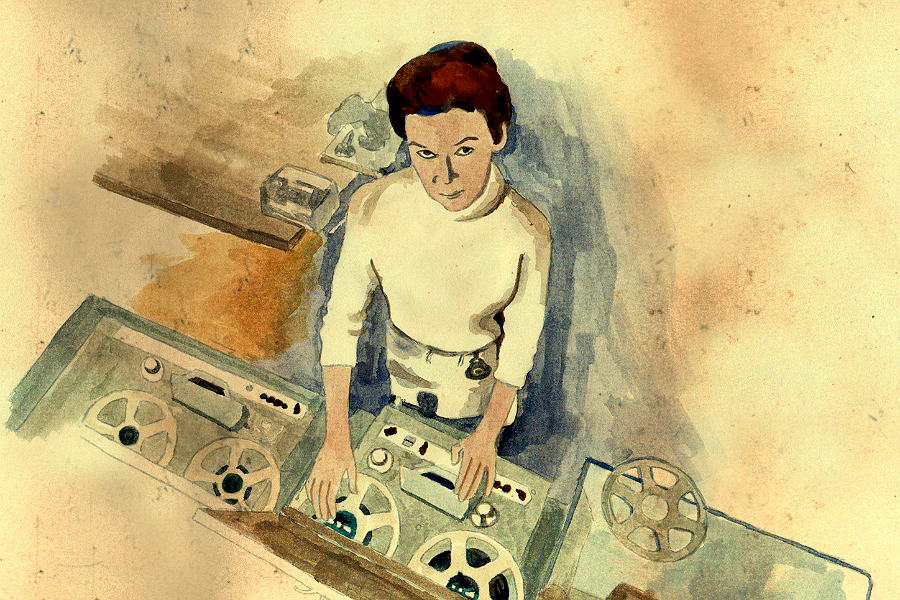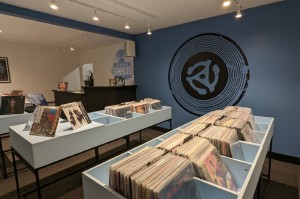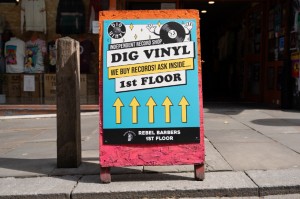Delia Darlings Reviewed

C James Fagan on Delia Derbyshire, a musical pioneer who continues to inspire…
This year sees the 50th anniversary of the world’s longest running science-fiction TV programme, the BBC’s Doctor Who, whose entrance into people’s living rooms across the country was heralded by its eerie, suitably unearthly theme tune. That tune was formed by Delia Derbyshire, so it seems more then fitting that this anniversary coincides with the creation of a day celebrating the pioneering spirit of Delia.
The inaugural Delia Derbyshire Day took place last week (on the 12th of January) in Manchester. That day consisted of talks from Delia-philes and performances by musicians in response to the Delia Derbyshire archive, housed at the University of Manchester. It marked the beginning of a small tour of the specially created music and also an attempt to generate interest in, and remind people of, the unique music of Derbyshire.
The first stop on that tour is FACT and this is where I find myself; I also find myself with two concerns. One being the large queue forming outside the box, the other being there’s a man wondering around with a trumpet. A trumpet seems somehow un-Delia, as far removed from the world of tape manipulation as an iPod is from a wax cylinder. I wonder how that piece of brass will relate to what I know about Delia’s Radiophonic world. I also wonder if I’ll get in.
While waiting to find out, I realise I wasn’t expecting this: Delia Derbyshire is still a cult figure, right? My surprise grows at the sight of a full house, but perhaps it’s a representation of how we, the British, treat the things that inspire, or are dear to us. We tend to hold these things close to us and expect we are the only ones who know about these special things. One of the unexpected results of events like this is the realisation that other people share a similar passion to you; that’s got to be a good thing.
Anyway that’s a bit of a digression. Once in to the performance space, I see a double bass laying down in-between two funereal clothed tables, each table covered in various pieces of musical equipment. I squat by the wall and, after a brief introduction, the first performers begin. The first piece is a composition by Ailis Ni Riain, entitled The Consequence of Falling, for double bass and trumpet.
The soft tunes of trumpet falls against the solid bass, while a projection of old scientific films describing the formation of the solar system plays. I can’t hear the connections between this rather haunting music and Delia Derbyshire; obviously they have taken inspiration from Delia and decided not to reproduce. I consider if this piece is some form of ‘soundtrack’ to a particular part of Delia’s life, I also begin to form a mental Venn diagram, where free jazz, modern composition and Delia meet. Though when the piece finishes I feel a little frustrated about it and its relation to Delia.
Quickly, the second piece is lined up, Naomi Kashiwagi’s Blue’s Gramophonica Remixed. Naomi kicks things off by hand-cranking a gramophone and dropping a dusty jazz tune. Whether this has relevance to a song which has import to Delia is unknown, that may be unimportant. Naomi also places a silver disc on another turntable which kicks out a shuffling heartbeat of a noise, which provides a bassline to the rest of proceedings. Naomi gets to work in manipulating the record on the gramophone, forcing it into loops, reconfiguring the original sound so the music forced into a feedback loop attempts to form a new piece of music.
The result is not unlike music by Susum Yokota or Oneohtrix Point Never. Mainly I see that this piece echo’s that idea of the physical manipulation of material in order to produce sound undertaken by Delia and The Radiophonic workshop. The whole piece has the sense of a sharing of a process as much as it is about the sounds being produced.
On to the final piece by Caro C, who sits behind a table full of loop stations and delays, cables spurting out from them. This piece is the one that is most akin to some of Delia’s work, and in a sense, it’s the piece that’s most in awe of the methods of Delia. The words she speaks in order to be manipulated deal with her wonder at the hands-on creation of the sounds from scratch, compared to her access to myriad sounds and equipment, which produce the same effects through the touch of a button. The piece is homage to both Delia and the process; it also shares a fascination with the manipulation of the human voice. It therefore comes as no surprise when Caro C tells us that she is a linguist.
This is followed by Kara Blake’s 25 minute film The Delian Mode, an insight into Delia’s life as it interweaves her inspirations (the unholy air raid sirens) with her methods at The Radiophonic workshop, to her mathematical approach to composing music. It serves as an excellent primer to the work of Delia Derbyshire and again, shows that Delia’s influence isn’t solely contained to the UK – Kara the director is Canadian.
Now it’s time for the Q&A session. Normally I wouldn’t mention this part, but it was an opportunity to hear the artists involved’s enthusiasm for the work of Delia Derbyshire and the project as a whole. Though it came across that Delia still remains somewhat of an enigma, some of her motivations – or why she stayed away from making music for so long – is unclear. For me it’s these ‘mysteries’ that allow Delia’s life and her music to become intertwined with your imagination.
During the event I did wonder if the creators of Delia Derbyshire Day where setting themselves a difficult task, to create an event that acknowledges the work of Delia and respond to it without succumbing to some kind of retro-futurism fetish. Clearly however, this is an event which can grow, and spread that spirit of creative endeavour in a way Delia would approve of.
C James Fagan





